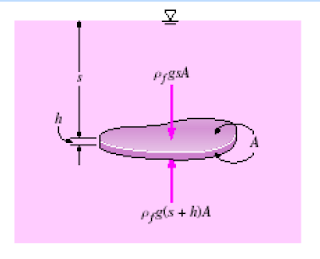- Pressure is defined as a normal force exerted by a fluid per unit area. Pressure is defined as force perunit area, it has the unit of newtons per square meter (N/m2), which is called a pascal (Pa).
- The actual pressure at a given position is called the absolute pressure, and it is measured relative to absolute vacuum (i.e., absolute zero pressure)
- Most pressure-measuring devices, however, are calibrated to read zero in the atmosphere and so they indicate the difference between the absolute pressure and the local atmospheric pressure.This difference is called the gage pressure.
- Pressures below atmospheric pressure are called vacuum pressures and are measured by vacuum gages that indicate the differencebetween the atmospheric pressure and the absolute pressure.
VARIATION OF PRESSURE WITH DEPTH
- Pressure in a fluid increases with depth because more fluid rests on deeper layers, and the effect of this “extra weight” on a deeper layer is balanced by an increase in pressure.
- If we take point 1 to be at the free surface of a liquid open to the atmosphere where the pressure is the atmospheric pressure Patm, then the pressure at a depth h from the free surface becomes P2
- Pressure in a fluid at rest is independent of the shape or cross section of the container. It changes with the vertical distance, but remains constant in other directions. Therefore, the pressure is the same at all points on a horizontal plane in a given fluid.
- pressure at a point is same in all directions. This is Pascal's law. This applies to fluid at rest.
PRESSURE MEASUREMENT
- MANOMETER
2. BAROMETER
- Atmospheric pressure is measured by a device called a barometer; thus, the atmospheric pressure is often referred to as the barometric pressure.
HYDROSTATIC FORCES
- On submerged plane surfaces.
- A plate exposed to a liquid, such as a gate valve in a dam, the wall of a liquid storage tank, or the hull of a ship at rest, is subjected to fluid pressure distributed over its surface
- On a plane surface, the hydrostatic forces form a system of parallel forces, and we often need to determine the magnitude of the force and its point of application, which is called the center of pressure.
BUOYANCY AND STABILITY
- The force that tends to lift the body is called the buoyant force and is denoted by FB. The buoyant force is caused by the increase of pressure in a fluid with depth.
- For floating bodies, the weight of the entire body must be equal to the buoyant force, which is the weight of the fluid whose volume is equal to the volume of the submerged portion of the floating body. That is, of uniform density, its weight Wsalso acts through the centroid, but its















No comments:
Post a Comment